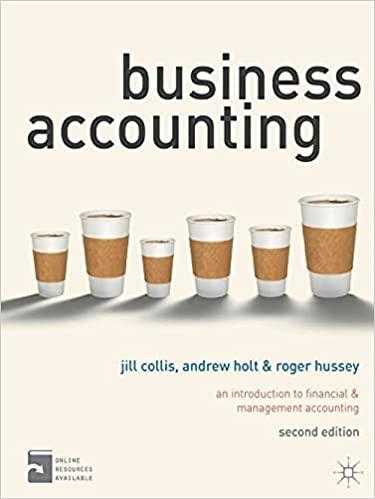Answered step by step
Verified Expert Solution
Question
...
1 Approved Answer
(20 Marks) Years ago, Company A purchased 18,000 of the 50,000 outstanding, voting shares of Company B for $95,000. Company A uses the equity method


(20 Marks) Years ago, Company A purchased 18,000 of the 50,000 outstanding, voting shares of Company B for $95,000. Company A uses the equity method to account for its investment in B, in its own accounting records. As of December 31, year 5, the balance of Company A's investment in Company B was $240,000. On that date, the shareholders' equity portion of B's balance sheet was: Common shares $380,000 Retained earnings 412,000 The following day, on January 1, year 6, Company A purchased an additional 20,000 B shares at the $18.00 market price. The book values of B's net assets, on that date, were equal to their fair values except for inventory that was overvalued by $10,000 and a building that was overvalued by $80,000. The building had a remaining useful life of 8 years. During year 6, Company B reported a net income of $150,000, declared/paid dividends of $24,000, and reported a goodwill impairment loss of $18,500 that year. Required: Write you answers by hand, scan your working papers and upload to the link on the main page of the Moodle website as a PDF file. Printing the problem information is permitted but only for personal use during the exam. Show all your calculations. a. Prepare A's journal entries for the year ended December 31, year 6 for its investment in Company B. b. It is now January 1, year 7. As Company A's Controller, you are exploring ways of reducing A's exposure in B, while maintaining a controlling interest. 1). Company A could sell 8,000 of its B shares to outside investors at $25 per share. Prepare the resulting journal entry (equity method). In your calculations, round any percentage figures to the nearest whole percentage (i.e., 11.88 = 12%). 2). Company B could issue an additional 8,000 common shares to other investors at $25 per share. Prepare the resulting journal entry (equity method). None of the new shares will be purchased by Company A. In your calculations, round any percentage figures to the nearest whole percentage (i.e. 11.88 = 12%). c. On that day. Company A decides to sell 10,000 shares on January 1, year 7. During the year, B earns a net income of $160,000 and pays a dividend of $21,000. There is no goodwill impairment during the year. Prepare the resulting journal entries for year 7. (20 Marks) Years ago, Company A purchased 18,000 of the 50,000 outstanding, voting shares of Company B for $95,000. Company A uses the equity method to account for its investment in B, in its own accounting records. As of December 31, year 5, the balance of Company A's investment in Company B was $240,000. On that date, the shareholders' equity portion of B's balance sheet was: Common shares $380,000 Retained earnings 412,000 The following day, on January 1, year 6, Company A purchased an additional 20,000 B shares at the $18.00 market price. The book values of B's net assets, on that date, were equal to their fair values except for inventory that was overvalued by $10,000 and a building that was overvalued by $80,000. The building had a remaining useful life of 8 years. During year 6, Company B reported a net income of $150,000, declared/paid dividends of $24,000, and reported a goodwill impairment loss of $18,500 that year. Required: Write you answers by hand, scan your working papers and upload to the link on the main page of the Moodle website as a PDF file. Printing the problem information is permitted but only for personal use during the exam. Show all your calculations. a. Prepare A's journal entries for the year ended December 31, year 6 for its investment in Company B. b. It is now January 1, year 7. As Company A's Controller, you are exploring ways of reducing A's exposure in B, while maintaining a controlling interest. 1). Company A could sell 8,000 of its B shares to outside investors at $25 per share. Prepare the resulting journal entry (equity method). In your calculations, round any percentage figures to the nearest whole percentage (i.e., 11.88 = 12%). 2). Company B could issue an additional 8,000 common shares to other investors at $25 per share. Prepare the resulting journal entry (equity method). None of the new shares will be purchased by Company A. In your calculations, round any percentage figures to the nearest whole percentage (i.e. 11.88 = 12%). c. On that day. Company A decides to sell 10,000 shares on January 1, year 7. During the year, B earns a net income of $160,000 and pays a dividend of $21,000. There is no goodwill impairment during the year. Prepare the resulting journal entries for year 7
Step by Step Solution
There are 3 Steps involved in it
Step: 1

Get Instant Access with AI-Powered Solutions
See step-by-step solutions with expert insights and AI powered tools for academic success
Step: 2

Step: 3

Ace Your Homework with AI
Get the answers you need in no time with our AI-driven, step-by-step assistance
Get Started



